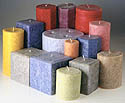All About Waxes
It seems that every year the number of waxes to choose from becomes more expansive. These days the candle maker has an infinite amount of choices to make when starting out or even looking at a new wax. During the selection process a basic decision has to be made between paraffin waxes, natural wax, “hybrid waxes” and even gels.
Within each of the above classifications there are many choices available. In previous articles we covered some of these waxes and topics. But with the continued introduction of new products it may be time to explore this topic again.
The largest segment of the market right now is paraffin wax candles. Paraffin waxes are available as a straight wax or as a blended wax. A generic definition of straight paraffin would be a wax that has no additives as part of the product. For optimum results, most straight waxes will require some type of additives to be used. A blend, on the other hand, would generally be a wax that is ready to go for the candle maker–no other additives are needed except for the scent and color. A blend and straight paraffin will have their own strengths and weaknesses. Straight waxes are generally available in melt point range of 120-160 degrees F.
There are a plethora of choices to make within the natural wax category also. These choices include beeswax (yellow and white), soy wax, vegetable base and even palm-based products. The yellow beeswax continues to be a popular choice among candle makers. This product is relatively easy to use and is a very consistent product. When doing containers a 100% soy product is the perennial choice. One of the drawbacks with all soy products has been their inability to retain large scent loads. Most soy waxes are capable of holding about 3 – 6% scent.
 One of the most novel products within the natural waxes category has to be the new “Design” waxes, which include F Wax, G Wax and Q Wax. These waxes allow candles to be made where each candle has a unique design and texture.
One of the most novel products within the natural waxes category has to be the new “Design” waxes, which include F Wax, G Wax and Q Wax. These waxes allow candles to be made where each candle has a unique design and texture.
One of the newest categories of waxes to “hit the market” is referred to by many as hybrids. These waxes, while they are not always promoted as such, are a combination of paraffin waxes and natural waxes. These waxes enjoy the benefits of the low shrinkage the soys offer combined with the positive scent retention and burning characteristics of paraffin waxes. Another new category is specialty waxes. Both categories of waxes typically are formulated to perform well for a specific application.

Votives made with
V Wax.

Containers made with J-300.
In most instances these complex formulations have been designed for specific application such as the V Wax. This new wax has been designed specifically as a one-pour wax for votives. The J-300 has been specifically designed to achieve “layering” in containers. With all of the different kinds of waxes and uses, it can be overwhelming at times to select the best one for your application.
